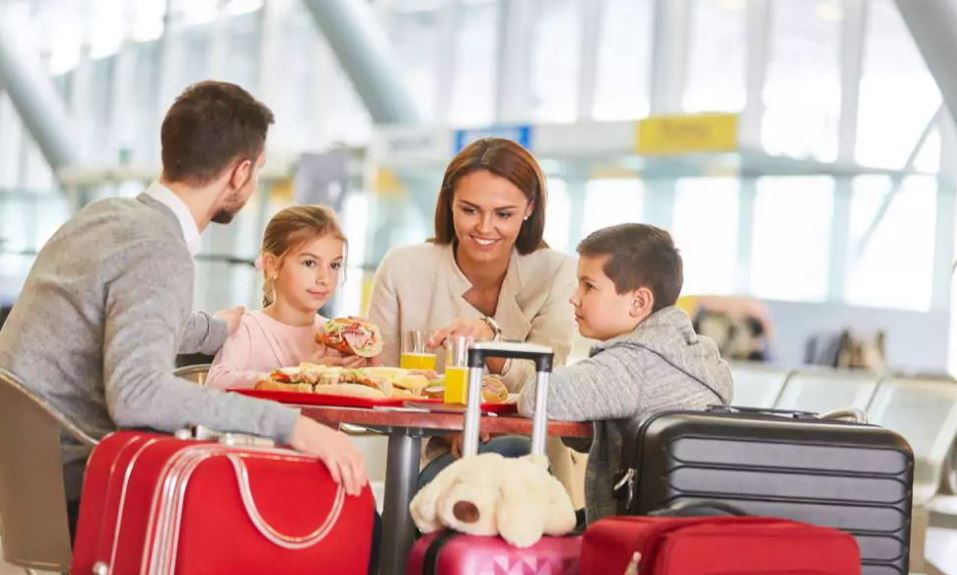If you’re heading out on a vacation, odds are, whipping up a snack for the airport is the last thing on your mind. Ensuring you’ve packed the right clothes, completed the proper travel forms, and checked into your flight are usually the top priorities. And that’s OK because airport dining has actually gotten pretty sophisticated, with some even boasting Michelin-starred establishments.
:max_bytes(150000):strip_icc():format(webp)/airport-foods-lead-DONTEAT0422-3c36e61068274cdf8bee289c0713290d.jpg)
However, there are still a few foods you should avoid both purchasing and eating at an airport, due to everything from their poor nutritional value to their potential to make you ill during your flight. Here are seven foods you should never buy at the airport.
Salad Bar
:max_bytes(150000):strip_icc():format(webp)/salad-bar-salads-DONTEAT0422-3417cf740e324753ba33241d3b695a3a.jpg)
A nice, leafy green salad may sound like the ideal healthy choice while traveling through the airport. However, the salad bar may also be a hotbed of germs, including the kind that can lead to food poisoning.
As the Centers for Disease Control and Prevention (CDC) shared on its website, though vegetables are an essential part of a healthy diet, “leafy greens, like other vegetables and fruits, are sometimes contaminated with harmful germs. Washing leafy greens does not remove all germs. That’s because germs can stick to the surface of leaves and even get inside them. If you eat contaminated leafy greens without cooking them first, such as in a salad or on a sandwich, you might get sick.” According to the CDC, “germs on produce eaten raw cause a large percentage of U.S. foodborne illnesses” and are a “major source of E. coli O157 infections.”
A Massive Coffee
:max_bytes(150000):strip_icc():format(webp)/giant-coffee-DONTEAT0422-b0fba4a864f04f7684568f94d0480189.jpg)
A warm, soothing coffee may be exactly what you’re craving before an early morning flight, but we suggest holding off if you can. That’s because coffee can not only lead to the jitters, but it can also send you to the bathroom in a rush, which will only be exacerbated 30,000 feet in the air.
Mayo Clinic reports, “Drinking caffeine-containing beverages as part of a normal lifestyle doesn’t cause fluid loss in excess of the volume ingested. While caffeinated drinks may have a mild diuretic effect — meaning that they may cause the need to urinate — they don’t appear to increase the risk of dehydration.” Furthermore, it notes, “Still, caffeinated drinks can cause headaches and insomnia in some people,” which isn’t fun if you’re trying to catch some Zs on your flight.
Salty French Fries and Pretzels
:max_bytes(150000):strip_icc():format(webp)/pretzels-salty-fries-DONTEAT0422-b2956e95373f40419f4e83448351a41f.jpg)
Salty foods like French fries and pretzels sure sound tasty, but even on the ground, these are a recipe for bloat. Pair that with a flight at 35,000 feet, and you’ll be a swollen mess.
As U.S. News explains, air pressure decreases at higher altitudes, which means gas, including the kind in your belly, will expand. “Whatever gas is in your gut as you board the plane — or that is created in your bowel during your flight as the result of food choices, or that enters into your bowel as the result of swallowed air or ingesting carbonated beverages — is likely to put more pressure against the bowel walls as altitudes rise.” So, if you can, avoid these salty treats and anything else that makes you bloat.
High-sugar Yogurts
:max_bytes(150000):strip_icc():format(webp)/sugary-yogurts-DONTEAT0422-148d821ce601451a9628c1ad7cd459ba.jpg)
If you’re in a rush and need a quick grab-and-go bite, those tiny yogurts might seem like the right choice. But beware because they could be hiding a ton of sugar, which isn’t an ideal choice before a flight.
Kara Landau, a dietitian from Australia and the brains behind TravellingDietitian.com, shared with the Food Network that she prefers to forgo yogurt parfaits and even fruit smoothies because of their added sugar and hidden additives as “that may aggravate the gut. I look for options that provide more protein, dietary fiber, and/or healthy fats with ‘cleaner line’ labels, such as plain Greek yogurt, nuts (that have not been roasted in added vegetable oils), chopped vegetables and hummus mixes, or natural nut or protein bars without artificial sweeteners or added sugars.”
Cocktails
:max_bytes(150000):strip_icc():format(webp)/cocktails-DONTEAT0422-51b7f288c5c145d69618214fa4ca97c4.jpg)
Having a beer, glass of wine, or cocktail in the airport before a flight is a rite of passage for many travelers who are looking to kick off their vacation in style. But maybe hold off on having a few too many because the effects in the air could be disastrous.
According to the KLM blog, “During a flight, the barometric pressure in the cabin of a plane is lower than it is in most places on Earth. You can compare it with an altitude in the mountains of between 1,800 and 2,200 meters. This decreased pressure environment diminishes the body’s ability to absorb oxygen and it can produce lightheadedness. We call this hypoxia. Generally speaking, this is not an issue, but the feeling could be similar to the experience you have after drinking alcohol.” The post adds that if you drink before or during a flight, you may notice this lightheadedness even faster. So, if you do indulge, make sure to have water in between each drink to keep yourself levelheaded.
Deli Meats
:max_bytes(150000):strip_icc():format(webp)/deli-meats-sandwiches-DONTEAT0422-396639fc310d418b887a017f9c7456dc.jpg)
Remember how we told you that salads could lead to food poisoning? Well, we’ve got some bad news for deli sandwich lovers, too. According to the CDC, packaged meats can also harbor harmful listeria, especially if they’ve been sitting out for some time. The CDC warns, “Avoid eating hot dogs, lunch meats, cold cuts, other deli meats (such as bologna), or fermented or dry sausages unless they are heated to an internal temperature of 165°F or until steaming hot just before serving.”
Sushi
:max_bytes(150000):strip_icc():format(webp)/airport-sushi-DONTEAT0422-94692526a8c34c7aaeff62e41ad37f02.jpg)
We apologize, but we’re going to ruin one more airport food for you: sushi. The CDC says it’s best to avoid “raw or undercooked fish, shellfish, or food containing raw or undercooked seafood, such as sashimi, some sushi, and ceviche.” Sushi can also pack a double whammy if you tend to drown it in soy sauce, which can have nearly 40% of your day’s worth of salt in a single tablespoon.

